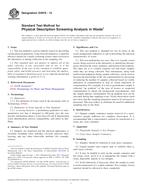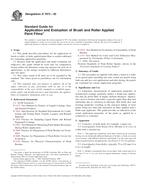1.1 This guide covers the functional elements and data records of prehospital Health Status Information Services (HSIS) needed to provide individual health status data for HSIS subscribers. When an HSIS subscriber experiences a medical emergency and becomes an EMS patient, a prehospital EMS care provider can rapidly access the individual’s health status data by means of telecommunications. Access to this data will enable the EMS provider to improve patient assessment, and thereby render more appropriate treatments. This will improve the EMS provider’s ability to stabilize trauma and other emergency medical conditions, and to restore and sustain vital functions, while avoiding treatments that may aggravate the severity of the medical emergency because of preexisting conditions.
1.2 In addition to improving on-site assessment, this guide will facilitate improved on-line medical direction of prehospital EMS care providers, particularly for persons experiencing life threatening medical emergencies.
1.3 Health status records provide a chronology of a person’s health/medical data, including past diagnosis and treatments. The data in these records provide a vital link between the person experiencing a medical emergency, the EMS care provider, and subsequent emergency services. In order to provide the most informed care, EMS care providers and persons providing EMS medical direction need to be aware of the injured or ill person’s health status.
1.4 This guide describes the minimum requirements for compiling, updating, computerizing, and storing individual’s longitudinal health status data in authorized repositories, so as to protect patient privacy and confidentiality. This guide also describes requirements for providing authorized access and rapid transmittal of the data to attending EMS care providers in medical emergencies.
1.5 While this guide addresses data needed for prehospital EMS, there is also a recognized essential, but largely unmet need for similar patient health status records for emergency medical care of patients in hospital emergency departments and in definitive medical care facilities. Many development projects are in process to address this unmet need. When available, such patient records are reviewed by attending physicians, in advance of hospital emergency medical care, to quickly access patient health status data that is needed for improved patient assessment and treatment and avoidance of treatments which may be contraindicated by preexisting conditions.
1.5.1 Future changes to this guide will result in health status information records for prehospital emergency medical care and analogous information systems for hospital emergency medical care, harmonized with each other and with future standards for computerized longitudinal health care patient records (see Guides E 1744 and F 1629) which are being developed by ASTM Committee E31.
1.5.2 This guide describes requirements that are based on current ASTM medical informatics standards and will be updated to harmonize with future versions of these rapidly evolving standards.
1.6 The scope of this guide includes harmonization of the definitions of prehospital emergency medical services data element definitions used in this guide with definitions used in other ASTM standards. The definition of data elements in this guide will be the same as the definition of the data element in other ASTM standards. In cases where a data element used in this guide does not appear in another ASTM standard, the guide will use the definition specified for federal health services information systems
Product Details
- Published:
- 02/01/2007
- Number of Pages:
- 18
- File Size:
- 1 file , 570 KB


